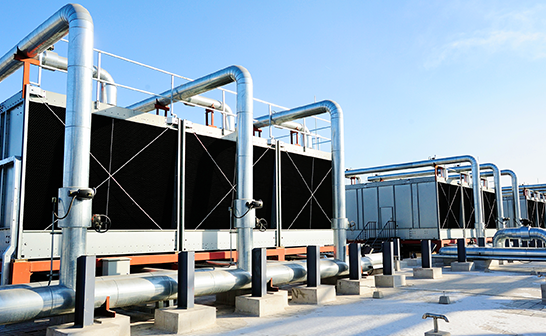Cooling Towers Best Practices
Cooling towers are large consumers of water, and as such are potentially one of the areas where the most savings are possible.
By fine-tuning and increasing your systems’ efficiency, you should see significant reductions in energy and water usage, and concomitant cost savings.

How Water Leaves a Cooling Tower
All water lost from the tower must be replaced by what is called make-up water.
1. Evaporation
Evaporation is how heat is transferred from the cooling tower system to the environment.
2. Drift
A small source of loss compared with others, drift is essentially mist or small droplets of water often carried from the tower.
3. Blowdown
Blowdown is the water drained from the cooling tower to remove mineral build-up. Carefully monitoring and controlling the quantity of blowdown provides the most significant opportunity to conserve water in cooling tower operations.
4. Basin Leaks or Overflows
Properly operated towers should not have leaks or overflows. Check float control equipment to ensure the basin level is being maintained properly, and check system valves to make sure there are no unaccounted for losses.
How to Reduce Cooling System Water Use
According to the government’s Office of Energy Efficiency and Renewable Energy, single-pass cooling can use as much as 40 times more water to remove the same heat load than a cooling tower operating at five cycles of concentration. The most significant step that can be taken to reduce water use, therefore, is to either eliminate single-pass cooling or, at a minimum, to reuse the water.
Finally, leaks or breaks in cooling towers can cause the systems to operate in an inefficient manner, wastewater, or even cause damage to the building and property. Worst of all, one may not even be aware of the leak for a significant period of time. WaterCompass offers real-time monitoring of water infrastructure. It’s a preemptive tool that provides visibility and awareness of leaks and breaks, helping to locate the problem before it turns catastrophic.
And Don’t Forget About Evaporation Credits
Evaporation credits or sewer credits can be a significant financial benefit for businesses that have sites using cooling towers or other evaporative equipment and may be available through water or utility agencies. These credits are for the water that evaporates from cooling towers, evaporative condensers, or even large ice machines. Incoming water is metered, but discharge (water going into drain lines) is typically not. Installing WaterCompass on the make-up and blowdown lines will allow for the calculation of evaporation loss and can be used to apply for credit against the sewer charge.
The savings are usually several thousand dollars a year per cooling tower. Because the equipment costs required to capture sewer credits are relatively low, return on investment can be as fast as 6 to 24 months. Perhaps the biggest advantage is the perpetual nature of sewer credits – if managed properly, credits usually recur year after year.

